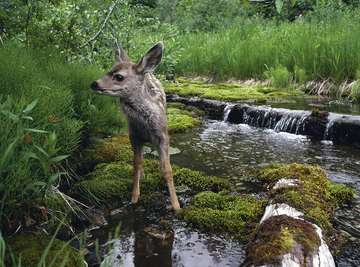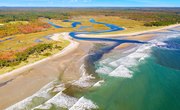
Ecosystems contain both biotic and abiotic factors. Biotic factors are the living parts of an environment, such as plants and animals. Abiotic factors are the non-living parts, such as minerals, gases and chemicals, as well as natural forces such as weather and geography. Both biotic and abiotic factors play a role in the health of an ecosystem.
TL;DR (Too Long; Didn't Read)
The biotic factors in an ecosystem are the living organisms, such as animals.
Biotic factors in an ecosystem are the participants in the food web, and they rely on each other for survival. A list of biotic factors includes those organisms that are producers, consumers and decomposers. The producers provide the food, generally in the form of plant life. Consumers eat the producers, or in the case of carnivores, other consumers. At the end of an organism’s life cycle, decomposers turn the organism's remains into organic material that can be used to provide energy for a new generation of producers.
These living organisms affect each other and influence the health of the ecosystem. A healthy ecosystem has a balance of biotic examples; a large increase or decrease in population of one species can impact many others. While abiotic factors are necessary to sustain life, biotic factors interact with and can more easily create changes in the environment.
A Balanced Ecosystem
An ecosystem needs abiotic factors to survive, but a balance of biotic factors makes it thrive. A balanced aquatic ecosystem has a sufficient number of planktonic algae to feed a number of zooplankton, which provide food and shelter for aquatic creatures such as small fish and aquatic insects. These small fish and insects then become prey for larger fish, which may then be eaten by even larger fish or marine life in the ocean and in freshwater, or by animals such as raccoons, bears or even humans. The plant life in these ecosystems also provides a renewable source of oxygen, which is necessary to sustain animal life both in and out of the water. An over- or underpopulation of a species can have a large effect on the ecosystem as a whole.
Terrestrial ecosystems look different than aquatic ones, but these also require a balanced food web. While the primary producers and decomposers are less visible than the consumers, they are more abundant and more productive. It is microscopic organisms that create new food sources for higher-level organisms through photosynthesis.
Microscopic Biotic Factors
Though they are small, microscopic biotic factors are crucial to the health of an ecosystem. These primary producers are the foundation of all life. They appear in greater numbers than other organisms and with the right conditions, multiply quickly. These organisms, primarily bacteria and plankton, provide food for more complex plants and animals that in turn provide food for those higher up in the food chain. Microscopic organisms are better able to adapt to unfavorable conditions and react less to environmental (abiotic) factors than larger organisms do as they can exist in a resting or dormant stage.
References
About the Author
Kimberly Yavorski is a freelance writer with a passion for learning, especially about nature, outdoors and the natural sciences. A longtime student of the life sciences, she served as a leader for Girl Scouts and 4H, sharing her interests by teaching children and teens about natural and environmental science and animal anatomy. Her work has also appeared on LetsGetOutside.us and Happy Science Mom. She can be found at www.kimberlyyavorski.com.
Photo Credits
Hemera Technologies/Photos.com/Getty Images
